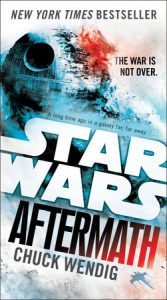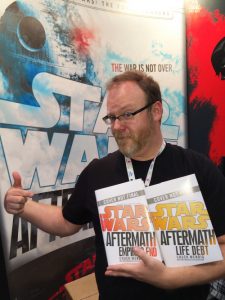[7-minute read]
“BRTN” is a periodic feature on JH.com, in which I write reviews/appreciations of books that are not exactly current. Today’s entry is, for me, rather timely; my last was on a John Updike memoir from 1989. The trouble is, time waits for no man — and neither does Chuck Wendig.
 The second Death Star is destroyed. The Emperor and his powerful enforcer, Darth Vader, are rumoured to be dead. The Galactic Empire is in chaos….Optimism and fear reign side by side.
The second Death Star is destroyed. The Emperor and his powerful enforcer, Darth Vader, are rumoured to be dead. The Galactic Empire is in chaos….Optimism and fear reign side by side.
And while the Rebel Alliance engages the fractured forces of the Empire, a lone rebel scout uncovers a secret imperial meeting…
This is how Star Wars: Aftermath by Chuck Wendig begins. If you need more background information than that, then you may not have been living in this hemisphere during the last number of decades, and maybe this 2015 novel isn’t for you. Wendig – about whom more later, but let’s just say now that he is phenomenally productive, and a review like this is at least three novels behind – adds full-length sequels in each of the next two years. The seemingly unbreakable Star Wars Rule of Threes continues its reign. Together, the trilogy forms part of a “new canon” of official SW material beyond the films themselves. Aftermath and its children form a bridge between the events of films over 30 years apart: 1983’s Return of the Jedi, and the grizzled-Han and dowager-Leia reunion in The Force Awakens (2015). (Yes, I know, other things happened, too. Luke, for example. And ‘droids. And light-saber battles.) I’m not an SW junkie, and don’t go near fan-sites or extended universes or fundamentalist skirmishes over what is and should be in the Star Wars canon. But like this novel, I do.
It is fast, inventive, breathless and constantly in the present tense, a Wendig trademark. Unknown characters appear in rapid succession, but with references to more or less familiar faces and names from the movies (Admiral Akbar, who does not age at all; C3P0, with upgrades). We know where we are, even when jetting into new worlds. On Coruscant, in one of Wendig’s several “Interludes” — short set-pieces that add context and flavour, and offer a place for him to stow away extra ideas — emboldened former Imperial citizens pull down a statue of Palpatine; see Hussein, Saddam, formerly of Iraq. Imperial Admiral Rae (she’s a woman!) Sloane has a toady and untrustworthy adjutant typecast to remind us of the unfortunate official Force-choked by Vader in the original Star Wars film. Although Wendig takes bitter criticism (surprise!) from many of the Star Wars faithful, Aftermath is an agreeable confection that blends the familiar with the rather wonderfully invented bridgework, with only the occasional bump.
The Empire is going, not gone. Akiva, as tropical a planet as Luke Skywalker’s Tattooine was dry, is now again crime-ridden, with ex-Imperials and ganglords competing for the spoils. Sinjir Rath Velus, himself a former Imperial Loyalty Officer, tries to drink his memories away. (Spoiler alert: he may not be a fully-fledged heterosexual!) Soon, we meet Norra Wexley (also a woman, and a mother, too!), returning to Akiva from the wars – she is an ace Rebel pilot – to be with her boy genius son and Certifiably Jaded Teen. He’s 15. Temmin Wexley misses his (heroic?) dad, resents his (absent!) mum, and seemingly has no love for anyone but a modified battle-bot of his own re-invention, the irrepressible Mister Bones.¹ The bounty-hunter trope returns, this time in the emphatically female shape of Jas Emari. Can you detect the force of a wildly diverse, incredibly unlikely (but essentially good-hearted) bunch of oddballs, loners, mavericks and machines coming together as a Team? Well, you bet!
¹ Mister Bones is my favourite character, actually. Wendig has a ball with him; Bones is a mash-up of the ALL CAPS conversational insistence of John Irving’s Owen Meany, the inventive violence of a John Rambo in First Blood (but with more charm), and the wingy logic of a teenaged Vulcan with an attitude. (And on meth.) Wendig admits it’s the invention he most hopes makes it into the newest trio of Star Wars films, those following TFA.
What is most interesting, though, is that we also get to know, and even have a little sympathy with, characters on the Imperial side. Admiral Sloane is the obvious one: she fights for respect within a misogynist Empire², and she is a point-of-view character whose struggles we can’t help identifying with. “We are not animals,” she says, both defending and rebuking her Imperial peers. We are nudged to acknowledge the positive aspects of the Empire – the order, the rule of law, the taming of criminal elements, the suppression of smaller disputes – and not merely the Orwellian “boot stamping on a human face – forever.” A fictional empire makes more sense when it does not require an endless supply of pure evil, and Wendig succeeds in fleshing out the context in which all the familiar jumps to hyperspace, the Force and its twin channels, and battles between X-wings and Y-wings occur. In his intermittent departures from the main story — the motley rebel crew, the Empire’s attempts to regain coherence — Wendig often returns to the politics of turning the Rebel victory into a sustainable, peaceful day-to-day reality for the galaxy. Mon Mothma, female leader of the Rebel senate, in one of the Interludes sagely intones, “We are not fighting the Empire just to become the Empire.”
² Her favourite and most trusted assistant, Morna Kee, is also a woman.
It’s fun, actually, and not just for Wendig. (But he had a blast.) He can’t resist naming one of the fat-cat profiteers from Imperial rule, an obscenely rich and spineless vulgarian, “Arsin Crassus”. He returns again and again to a deliciously silly kind of cowboy pseudo-profanity, invented curses that are immune to deletion because the author made ’em up. Wendig doesn’t try to restrain his love for outrageous similes, such as the time a character eats something which “tasted like he’d just licked the back end of a bantha”. (Were I more of a Star Wars geek, I’d be more sure that this beast has a pre-Wendig existence in the SW universe. I think it does.) At another point, the Empire’s former Grand Moff Pandion mutters, “The Ravager is a powerful weapon, and Sloane is sitting on it like a fat nuna hen upon a nest of already hatched eggs.” Temmin Wexley, the adolescent genius, engages in a stirring version of Galactic parkour, that current craze for city-sport running and jumping, staying one extremely cool step ahead of the too slow again pursuits of the ponderous Empire’s minions. And of course, there are numerous Hair’s Breadth Escapes and Incredible Cliffhanger Fortune for the Good Guys; surely Darth Vader undervalues this obvious side-benefit to those who favour the enlightened side of The Force. We also get a glimpse into life inside those white Imperial Stormtroopers’ suits, and the men who are wearing them, but Wendig doesn’t answer the eternal question of yours truly, an admitted Rebel sympathizer: why do they even bother wearing plastic armour? It doesn’t protect them from anything! And why are they such terrible shots? But we do get a look at their faces and the grind of their infantry-grunt lives. Hey, Wendig says in effect, it’s no picnic being a Stormtrooper, especially when things start to get hot for the Bad Guys.
Clear Recommendation Number TWO, in case you’re still in doubt: if you have read this far, and found some of this review even mildly appealing or interesting, then you might safely take a stab at Chuck Wendig’s Aftermath. As usual, I came to the book via an interesting back door. Margaret Atwood, a seemingly unlikely literary buddy for Wendig, sent me stumbling Chuck-ward, specifically toward his Terrible Minds blog. He writes hilariously, pyrotechnically, rudely and smartly on heritage apples, his nutty-brainy son, American politics³ and the backwoods of “Pennsyltucky”, but mainly on writing. He’s a blazingly encouraging, NSFW, breathless but no-bullshit advisor to would-be scribblers. (Atwood’s praise for his blog, and a wry mention of his “naughtiness”, sent me there. Wendig, in turn, is blushingly pumped about how his combination of Kick-Ass Writing Coach and Astonishingly Productive Spec-Fiction Author has brought him into the Atwood Orbit.) Somewhere along the social media line, Wendig please, please, pretty-pleased the Forces of the Star Wars Universe, and — it pays to ask for what you want! — the success of his earlier sci-fi/fantasy/thriller novels and his Omnipresent Geekery got him the gig.
³ If you enjoy detesting, say, a recent electoral victor in a major world power, you’d enjoy Wendig’s volcanic leftward vitriol. It’s intelligent, it’s compassionate, but it doesn’t try to bridge the American divide. He is Mister Bones when it comes to opposing what he sees as the worst of right-wing beliefs and attitudes. He is nothing if not colourful.

The Pennsyltuckian Writing Devil-Dervish himself. He’s an appealing character himself. (photo gratefully pinched from another Word Press blog)
I finished Aftermath months ago, mea culpa on the time gap — heck, I’m no Chuck Wendig! — and if I can extract myself from some of the heavy-duty reading I’ve been (gladly) immersing myself in, I’d willingly go back to pick up where he left off: SW Aftermath: Life Debt. The third novel in his (again, gotta say it, Wendig is astoundingly productive) rapidly-produced-but-well-written trilogy is ALREADY out in paperback. He has been a controversial choice among many fans, mainly for his insistence on including greater ethnic and gender diversity among his characters. (Again, his recent commentary on SW Aftermath: Empire’s End is worth a read, if you’re interested in knowing his general take on having helped to create a portion of the Star Wars expanded universe, and especially his unapologetic explanation for why, in the 21st century, we might want to nourish a little less fear of diversity, whether in real life or in fictive fantasy worlds.) I knew of the reactionary blowback — he’s forcing his gay agenda down our innocent inter-galactic throats! — before I read the book. Perhaps because I was forewarned, or maybe because it’s just not that big a deal in the narrative (they exist!), I found the treatment undistracting and inoffensive, in case that’s important to you.
Aftermath is space cowboys and shootouts, a morality play among the stars, just as the whole Star Wars phenomenon is. It’s not enduring literature, but I’ve enjoyed travelling to that galaxy. I liked Chuck Wendig’s hyperactive introduction to new elements of a far-away time, and I’ll go again.

There is nothing quite like a fast-moving, interesting and insightful review which provides bonus material on what is going on in the real world. Lovely!